Abstract
The valence band offset between Cs2AgBiBr6 and hole transport layer (HTL) is approximately 1.00 eV, which results in high energy loss and is identified as one of the bottle necks of Cs2AgBiBr6 perovskite solar cell (PSC) for achieving high power conversion efficiency (PCE). To tackle this problem, we propose the optimization of the energy level alignment by designing and synthesizing novel deep-level hole transport materials (HTMs). The sole introduction of deep-level HTMs successfully reduces the valence band offset between Cs2AgBiBr6 and HTL, but induces the increased valence band offset at HTL/Au interface, limiting the PCE improvement. To further solve the problem and improve the PCE, the gradient energy level arrangement is constructed by combining the newly developed deep-level HTM 6,6'-(3-((9,9-dimethyl-9H-fluoren-3-yl)(4-methoxyphenyl)amino)thiophene-2,5-diyl)bis(N-(9,9-dimethyl-9H-fluoren-2-yl)-N,9-bis(4-methoxyphenyl)-9H-carbazol-3-amine) (TF) with 2,2',7,7'-tetrakis(N,N’-di-pmethoxyphenylamine)-9,9-spirobifluorene (Spiro-OMeTAD). Through optimization, an impressive PCE of 3.50% with remarkably high open-circuit voltage (Voc) and fill factor (FF) is achieved, qualifying it among the best pristine Cs2AgBiBr6 PSCs.
Graphical abstract

摘要
Cs2AgBiBr6/空穴传输层(HTL)界面处约1.00 eV的能势差导致电荷传输过程中能量损失过大,这被认为是限制Cs2AgBiBr6钙钛矿太阳能电池(PSC)光电率转换效率(PCE)进一步提升的瓶颈之一。为了解决这个难题,本论文提出通过设计与合成新型深能级空穴传输材料(HTM),优化能级排列,以降低界面能量损失。研究发现,单一引入深能级HTM虽然成功地减少了Cs2AgBiBr6和HTL之间的能量损失,但会同时引发HTL/Au界面处能量损失增加。为了进一步解决该问题并提升器件PCE,我们通过将新开发的深能级HTM TF与Spiro-OMeTAD相结合,构建出梯度排列的能级,成功降低了空穴传输界面的电荷复合和能量损失。通过优化,器件最终获得了3.50%的PCE,且具有较高的开路电压(Voc)和填充因子(FF),使其成为基于原始Cs2AgBiBr6的最佳效率之一。





Similar content being viewed by others
References
Farokhi A, Shahroosvand H, Monache GD, Pilkington M, Nazeeruddin MK. The evolution of triphenylamine hole transport materials for efficient perovskite solar cells. Chem Soc Rev. 2022;51(14):5974. https://doi.org/10.1039/D1CS01157J.
Kojima A, Teshima K, Shirai Y, Miyasaka T. Organometal halide perovskites as visible-light sensitizers for photovoltaic cells. J Am Chem Soc. 2009;131(17):6050. https://doi.org/10.1021/ja809598r.
Kim GH, Kim DS. Development of perovskite solar cells with >25% conversion efficiency. Joule. 2021;5(5):1033. https://doi.org/10.1016/j.joule.2021.04.008.
Wu JB, Zhen C, Liu G. Photo-assisted Cl doping of SnO2 electron transport layer for hysteresis-less perovskite solar cells with enhanced efficiency. Rare Met. 2022;41(2):361. https://doi.org/10.1007/s12598-021-01812-2.
Li Z, Li B, Wu X, Sheppard SA, Gao D, Long NJ, Zhu ZL. Organometallic-functionalized interfaces for highly efficient inverted perovskite solar cells. Science. 2022;376(6951):416. https://doi.org/10.1126/science.abm8566.
National Renewable Energy Laboratory Efficiency Chart, plotted from 1976 to 2023. Accessed from. www.nrel.gov/pv/cell-efficiency.html
Khadka DB, Shirai Y, Yanagida M, Tadano T, Miyano K. Interfacial embedding for high-efficiency and stable methylammonium-free perovskite solar cells with fluoroarene hydrazine. Adv Energy Mater. 2022;12(38):2202029. https://doi.org/10.1002/aenm.202202029.
Zhao D, Gao DP, Wu X, Li B, Zhang SF, Li Z, Wang Q, Wu ZX, Zhang CL, Choy CHC, Zhong XY, He QY, Zhu ZL. Efficient and stable 3D/2D perovskite solar cells through vertical heterostructures with (BA)4AgBiBr8 nanosheets. Adv Mater. 2022;34(39):2204661. https://doi.org/10.1002/adma.202204661.
Zhang YH, Li Y. Interface materials for perovskite solar cells. Rare Met. 2021;40(11):2993. https://doi.org/10.1007/s12598-020-01696-8.
Liu ZH, Qiu LB, Ono LK, He SS, Hu ZH, Jiang MW, Tong GQ, Wu ZF, Jiang Y, Son DY, Dang YY, Kazaoui S, Qi YB. A holistic approach to interface stabilization for efficient perovskite solar modules with over 2000-hour operational stability. Nat Energy. 2020;5:596. https://doi.org/10.1038/s41560-020-0653-2.
Yang XY, Li QY, Zheng YF, Luo DY, Zhang YZ, Tu YG, Zhao LC, Wang YJ, Xu F, Gong QH, Zhu R. Perovskite hetero-bilayer for efficient charge-transport-layer-free solar cells. Joule. 2022;6(6):1277. https://doi.org/10.1016/j.joule.2022.04.012.
Supasai T, Rujisamphan N, Ullrich K, Chemseddine A, Dittrich T. Formation of a passivating CH3NH3PbI3/PbI2 interface during moderate heating of CH3NH3PbI3 layers. Appl Phy Lett. 2013;103(18):183906. https://doi.org/10.1063/1.4826116.
Conings B, Drijkoningen J, Gauquelin N, Babayigit A, D’Haen J, D’Olieslaeger L, Ethirajan A, Verbeeck J, Manca J, Mosconi E, Angelis FD, Boyen HG. Intrinsic thermal instability of methylammonium lead trihalide perovskite. Adv Energy Mater. 2015;5(15):1500477. https://doi.org/10.1002/aenm.201500477.
Wu PF, Wang SR, Li XG, Zhang F. Beyond efficiency fever: preventing lead leakage for perovskite solar cells. Matter. 2022;5(4):1137. https://doi.org/10.1016/j.matt.2022.02.012.
Babayigit A, Ethirajan A, Muller M, Conings B. Toxicity of organometal halide perovskite solar cells. Nat Mater. 2016;15:247. https://doi.org/10.1038/nmat4572.
Giustino F, Snaith HJ. Toward lead-free perovskite solar cells. ACS Energy Lett. 2016;1(6):1233. https://doi.org/10.1021/acsenergylett.6b00499.
Liu Y, Nag A, Manna L, Xia ZG. Lead-free double perovskite Cs2AgInCl6. Angew Chem. 2021;60(21):11592. https://doi.org/10.1002/anie.202011833
Luo HQ, Li PW, Ma JJ, Han LY, Zhang YQ, Song YL. Sustainable Pb management in perovskite solar cells toward eco-friendly development. Adv Energy Mater. 2022;12(30):2201242. https://doi.org/10.1002/aenm.202201242.
Shi ZJ, Guo J, Chen YH, Li Q, Pan YF, Zhang HJ, Xia YD, Huang W. Lead-free organic-inorganic hybrid perovskites for photovoltaic applications: recent advances and perspectives. Adv Mater. 2017;29(16):1605005. https://doi.org/10.1002/adma.201605005.
Filippo DA. The prospect of lead-free perovskite photovoltaics. ACS Energy Lett. 2021;6:1586. https://doi.org/10.1021/acsenergylett.1c00636.
Sun N, Gao WY, Dong H, Liu YH, Liu X, Wu ZB, Song L, Ran CX, Chen YH. Architecture of p-i-n Sn-based perovskite solar cells: characteristics, advances, and perspectives. ACS Energy Lett. 2021;6(8):2863. https://doi.org/10.1021/acsenergylett.1c01170.
Zhu Z, Jiang XY, Yu DN, Yu N, Ning ZJ, Mi QX. Smooth and compact FASnI3 films for lead-free perovskite solar cells with over 14% efficiency. ACS Energy Lett. 2022;7(6):2079. https://doi.org/10.1021/acsenergylett.2c00776.
Lei HW, Hardy D, Gao F. Lead-free double perovskite Cs2AgBiBr6: fundamentals, applications, and perspectives. Adv Funct Mater. 2021;31(49):2105898. https://doi.org/10.1002/adfm.202105898.
Li B, Wu X, Zhang SF, Li Z, Gao DP, Chen XK, Xiao S, Chueh CC, Jen AKY, Zhu ZL. Efficient and stable Cs2AgBiBr6 double perovskite solar cells through in-situ surface modulation. Chem Eng J. 2022;446(3):137144. https://doi.org/10.1016/j.cej.2022.137144.
Zhang ZY, Sun QD, Lu Y, Lu F, Mu XL, Wei SH, Sui ML. Hydrogenated Cs2AgBiBr6 for significantly improved efficiency of lead-free inorganic double perovskite solar cell. Nat Commun. 2022;13(1):3397. https://doi.org/10.1038/s41467-022-31016-w.
Tress W, Sirtl MT. Cs2AgBiBr6 double perovskites as lead-free alternatives for perovskite solar cells. Solar RRL. 2021;6(2):2100770. https://doi.org/10.1002/solr.202100770.
Wang BN, Li N, Yang L, Dall’Agnese C, Jena AK, Miyasaka T, Wang XF. Organic dye/Cs2AgBiBr6 double perovskite heterojunction solar cells. J Am Chem Soc. 2021;143(36):14877. https://doi.org/10.1021/jacs.1c07200.
Wang BN, Li N, Yang L, Dall’Agnese C, Jena AK, Sasaki SI, Miyasaka T, Tamiaki H, Wang XF. Chlorophyll derivative-sensitized TiO2 electron transport layer for record efficiency of Cs2AgBiBr6 double perovskite solar cells. J Am Chem Soc. 2021;143(5):2207. https://doi.org/10.1021/jacs.0c12786.
Bekenstein Y, Dahl JC, Huang J, Osowiecki WT, Swabeck JK, Chan EM, Yang P, Alivisatos AP. The making and breaking of lead-free double perovskite nanocrystals of cesium silver-bismuth halide compositions. Nano Lett. 2018;18(6):3502. https://doi.org/10.1021/acs.nanolett.8b00560.
Wu H, Wang YF, Liu AJ, Wang JX, Kim BJ, Liu YW, Fang Y, Zhang XL, Boschloo G, Johansson EMJ. Methylammonium bromide assisted crystallization for enhanced lead-free double perovskite photovoltaic performance. Adv Funct Mater. 2021;32(14):2109402. https://doi.org/10.1002/adfm.202109402.
Luo T, Zhang YL, Chang XM, Fang JJ, Niu TQ, Lu J, Fan YY, Ding ZC, Zhao K, Liu SZ. Dual interfacial engineering for efficient Cs2AgBiBr6 based solar cells. J Energy Chem. 2021;53:372. https://doi.org/10.1016/j.jechem.2020.05.016.
Sirtl MT, Hooijer R, Armer M, Ebadi FG, Mohammadi M, Maheu C, Weis A, van Gorkom BT, Häringer S, Janssen RAJ, Mayer T, Dyakonov V, Tress W, Bein T. 2D/3D hybrid Cs2AgBiBr6 double perovskite solar cells: improved energy level alignment for higher contact-selectivity and large open circuit voltage. Adv Energy Mater. 2022;12(7):2103215. https://doi.org/10.1002/aenm.202103215.
Yang XQ, Chen YH, Liu PY, Xiang HM, Wang W, Ran R, Zhou W, Shao ZP. Simultaneous power conversion efficiency and stability enhancement of Cs2AgBiBr6 lead-free inorganic perovskite solar cell through adopting a multifunctional dye interlayer. Adv Funct Mater. 2020;30(23):2001557. https://doi.org/10.1002/adfm.202001557.
Guo ZL, Jena AK, Kim GM, Miyasaka T. The high open-circuit voltage of perovskite solar cells: a review. Energy Environ Sci. 2022;15:3171. https://doi.org/10.1039/D2EE00663D.
Yang X, Wang W, Ran R, Zhou W, Shao ZP. Recent advances in Cs2AgBiBr6-based halide double perovskites as lead-free and inorganic light absorbers for perovskite solar cells. Energy Fuels. 2020;34(9):10513. https://doi.org/10.1021/acs.energyfuels.0c02236.
Xiang WC, Liu SZ, Tress W. Interfaces and interfacial layers in inorganic perovskite solar cells. Angew Chem. 2021;60(51):26440. https://doi.org/10.1002/anie.202108800.
Zhou J, Tian YQ, Yi YX, Wu YZ, Liu B. Star-shaped D-π-D hole-transporting materials regulated by molecular planarity and their application in efficient perovskite solar cells. J Power Sour. 2021;506(15):230102. https://doi.org/10.1016/j.jpowsour.2021.230102.
Lamberti F, Schmitz F, Chen W, He ZB, Gatti T. The non-innocent role of hole-transporting materials in perovskite solar cells. Solar RRL. 2021;5(10):2100514. https://doi.org/10.1002/solr.202100514.
Jiang K, Wang J, Wu F, Xue QF, Yao Q, Zhang JQ, Chen YH, Zhang GY, Zhu ZL, Yan H, Zhu LN, Yip HL. Dopant-free organic hole-transporting material for efficient and stable inverted all-inorganic and hybrid perovskite solar cells. Adv Mater. 2020;32(16):e1908011. https://doi.org/10.1002/adma.201908011.
Wang J, Wu X, Liu YZ, Qin T, Zhang KC, Li N, Zhao J, Ye RQ, Fan ZX, Chi ZG, Zhu ZL. Dopant-free hole-transporting material with enhanced intermolecular interaction for efficient and stable n-i-p perovskite solar cells. Adv Energy Mater. 2021;11(29):2100967. https://doi.org/10.1002/aenm.202100967.
Akin S, Bauer M, Hertel D, Meerholz K, Zakeeruddin SM, Graetzel M, Bäuerle P, Dar MI. Robust nonspiro-based hole conductors for high-efficiency perovskite solar cells. Adv Funct Mater. 2022. https://doi.org/10.1002/adfm.202205729.
Zhu H, Shen Z, Pan L, Han J, Eickemeyer FT, Ren Y, Li X, Wang S, Liu H, Dong X, Zakeeruddin SM, Hagfeldt A, Liu Y, Grätzel M. Low-cost dopant additive-free hole-transporting material for a robust perovskite solar cell with efficiency exceeding 21%. ACS Energy Lett. 2020;6(1):208. https://doi.org/10.1021/acsenergylett.0c02210.
Ji T, Wang YK, Feng L, Li GH, Wang WY, Li ZF, Hao YY, Cui YX. Charge transporting materials for perovskite solar cells. Rare Metals. 2021;40(10):2690. https://doi.org/10.1007/s12598-021-01723-2.
Nazeeruddin MK, Liu C, Igci C, Yang Y, Syzgantseva OA, Syzgantseva MA, Rakstys K, Kanda H, Shibayama N, Ding B, Zhang XF, Jankauskas V, Ding Y, Dai SY, Dyson P. Dopant-free hole transport materials afford efficient and stable inorganic perovskite solar cells and modules. Angew Chem. 2021;60(37):20489. https://doi.org/10.1002/anie.202107774.
Wang BY, Wang HX, Sathiyan G, Chen C, Xu Y, Cheng M. Constructing efficient hole-transporting materials by tuning fluorine substitution for inverted perovskite solar cells with efficiency exceeding 20%. ACS Appl Energy Mater. 2022;5(5):5901. https://doi.org/10.1021/acsaem.2c00223.
Fu Q, Liu H, Tang XC, Wang R, Chen MQ, Liu YS. Multifunctional two-dimensional polymers for perovskite solar cells with efficiency exceeding 24%. ACS Energy Lett. 2022;7(3):1128. https://doi.org/10.1021/acsenergylett.1c02812.
Subhani WS, Wang K, Du MY, Wang XL, Liu SZ. Interface-modification-induced gradient energy band for highly efficient CsPbIBr2 perovskite solar cells. Adv Energy Mater. 2019;9(21):1803785. https://doi.org/10.1002/aenm.201803785.
Zhan S, Duan YW, Liu ZK, Yang L, He K, Che YH, Zhao WJ, Han Y, Yang SM, Zhao GT, Yuan NY, Ding JN, Liu SZ. Stable 2429%-efficiency FA0.85MA0.15PbI3 perovskite solar cells enabled by methyl haloacetate-lead dimer complex. Adv Energy Mater. 2022;12(27):2200867. https://doi.org/10.1002/aenm.202200867.
Wang N, Zhao KX, Ding T, Liu WB, Ahmed AS, Wang ZR, Tian MM, Sun XW, Zhang QC. Improving interfacial charge recombination in planar heterojunction perovskite photovoltaics with small molecule as electron transport layer. Adv Energy Mater. 2017;7(18):1700522. https://doi.org/10.1002/aenm.201700522.
Zhou J, Yin XX, Dong ZH, Ali A, Song ZN, Shrestha N, Bista SS, Bao QY, Ellingson RJ, Yan YF, Tang WH. Dithieno[3,2-b2’,3’-d]pyrrole cored p-type semiconductors enabling 20% efficiency dopant-free perovskite solar cells. Angew Chem. 2019;58(39):13717. https://doi.org/10.1002/anie.201905624.
Acknowledgements
This work was financially supported by the National Natural Science Foundation of China (Nos. 22179053, 22279046 and 21905119), the Natural Science Excellent Youth Foundation of Jiangsu Provincial (No. BK20220112), the Open Competition Mechanism Project of Carbon Neutrality of Jiangsu Province (No. BE2022026). L. Wang thanks Zhejiang Province Selected Funding for Postdoctoral Research Projects (No. ZJ2021001) for financial support. The authors would like to thank Dr. Yinjuan Chen at Westlake University for HRMS measurements and thank Weiwei Wang from Shiyanjia Lab (www.shiyanjia.com) for UPS measurements.
Author information
Authors and Affiliations
Corresponding authors
Ethics declarations
Conflict of interests
The authors declare that they have no conflict of interest.
Supplementary Information
Below is the link to the electronic supplementary material.
Rights and permissions
Springer Nature or its licensor (e.g. a society or other partner) holds exclusive rights to this article under a publishing agreement with the author(s) or other rightsholder(s); author self-archiving of the accepted manuscript version of this article is solely governed by the terms of such publishing agreement and applicable law.
About this article
Cite this article
Xia, ZY., Zhang, W., Chen, C. et al. Improving performance of Cs2AgBiBr6 solar cell through constructing gradient energy level with deep-level hole transport material. Rare Met. 42, 3004–3012 (2023). https://doi.org/10.1007/s12598-023-02320-1
Received:
Revised:
Accepted:
Published:
Issue Date:
DOI: https://doi.org/10.1007/s12598-023-02320-1




